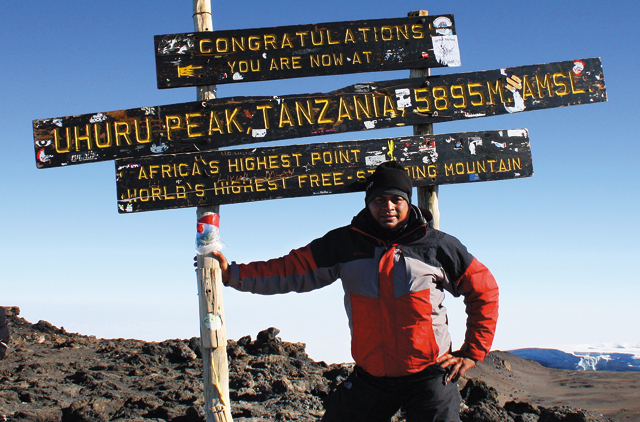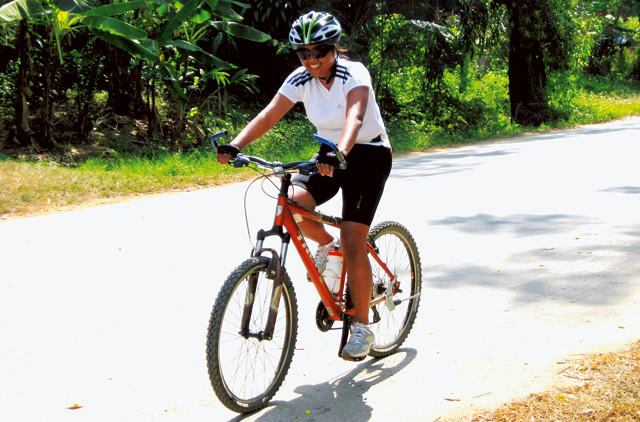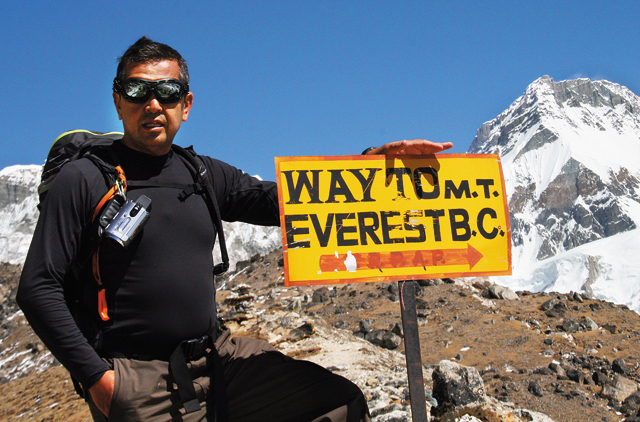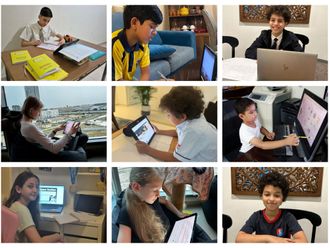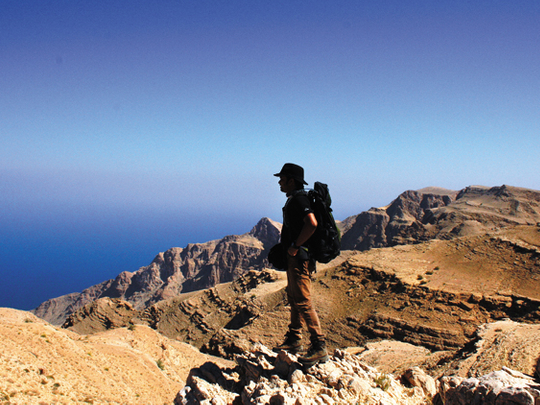
Gasping for breath, Girish Shivanand stumbles forward. His vision is slightly blurred and his feet heavy but he refuses to stop. He is just metres away from climbing to the peak of Kilimanjaro, the highest mountain in Africa. He's tired and is suffering from lack of oxygen. Minutes away from accomplishing a Gulf for Good charitable adventure, Girish pauses to think about the children who will benefit from his success.
"The burst of energy that followed was as much for the children in Tanzania, who would be able to study in a proper school from the money I raised as it was for my own satisfaction of having conquered the Kilimanjaro," says Girish, 35, a research and development manager with Unilever in Dubai.
That's the satisfaction Gulf for Good challenge participants get - they raise money for children's charities around the world and push their personal limits.
The premise of the charity is simple. Volunteers have to raise a set amount of money in order to participate in one of the challenges, which have included trekking through Ethiopia, ascending to Everest Base Camp, hiking Machu Picchu in Peru or cycling through the seven emirates of the UAE.
Gulf for Good organises physical training before the trip and transport to the country, guides, accommodation and food while there.
The charity is registered with Dubai International Humanitarian City and in the UK and all the money raised goes towards children's projects in the country of the challenge. Volunteers even get a chance to visit the projects they are funding.
Since 2001, Gulf for Good has helped raise over Dh6.6m for many causes around the world. It has helped build orphanages, homes, hospitals and funded education.
"Our first challenge had 49 people climbing the Kilimanjaro," says Brian Wilkie who is the chairman of the organisation.
"The funds raised paid for four ambulances for poor communities in Tanzania, Malawi and Namibia. We've done 35 challenges since then and involved well over 750 people of 41 nationalities," he says. "The challenges have been held in 20 countries and we've raised money for 34 charities."
Since then, the challenges have been many and varied, including hiking, cycling, kayaking, horse riding and even camel riding. "Initially, the money was used for various projects: establishing schools and buying medical equipment but from 2007 we've been focusing on children's charities," says Brian.
"Children are usually the victims of any major upheaval, whether it's war, a natural disaster or an epidemic," he says. "You have to see that they are looked after and educated. It's only after ensuring they're taken care of that one can look to change the world."
Girish Shivanand, 35, R & D manager, Unilever
The first reason I took the challenge was for the charity. The money went to education for under-privileged children. I believe that most problems can be solved with education and that's why I was so attracted to Gulf For Good's challenges. I've been privileged to be educated but in developing countries so many children grow up disadvantaged. I'd always felt the need to do something about it and to help make a difference in their lives. Life is a challenge and the more capable you are, the better you face it. That's the attraction of the physical challenges. You discover new sides of yourself while facing the obstacles.
I read about the charity's challenges in Gulf News. My first challenge was in July 2009, hiking around the ruins of Machu Pichu in Peru. I had to raise Dh24,000 for the mountain kids of the region, to construct a new school in Quilla Huata - including building classrooms, a kitchen, toilets, and play areas.
The children had to hike very long distances across mountains to go to school. The village also had no access to clean drinking water so it was a great motivation for me. Though I had donated to charities before, I had the experience of both raising money as well as seeing the people who would benefit from it. Taking part improves not just the lives of others but our own lives too. Doing good for others does us good.
It was not easy raising the money for the first challenge. I learnt a new part of my personality - that I'd never give up once I'd taken up a cause. I've done three challenges so far. It's not just money you're giving these people, you're giving a part of yourself too.
Abigail Simpson, 34, senior risk consultant with Marsh Risk Consulting
I visited Nepal last year and while overwhelmed by the beauty of the countryside and the friendliness of the Nepali people, I was shocked and saddened at the number of young children living and begging on the streets in Kathmandu.
A few months later when I was back at home, a friend told me that Gulf for Good was planning a trek to Everest Base Camp to raise money for an orphanage just outside Kathmandu. I'd never done anything like this before. But it meant the chance of a better life for the children, and a huge personal challenge for me - to raise Dh19,000 and reach Everest Base Camp.
Initially I had no idea how I'd raise the money. However, my friends and colleagues pitched in and helped organise a bake sale in the office, a stand at Safa Park Flea Market and a quiz night. People were very generous.
I set off on October 14, with 20 other people. I didn't know anyone before but returned with 20 new friends of different nationalities, backgrounds and ages. We enjoyed the ups and downs of an unforgettable two-week, life-changing experience. It was touching meeting the children. The poverty there is striking, but the orphanage gives you hope that things will get better.
Elias Sejean, director of international sales for Love and Quiches Desserts, Dubai
I took the trip because the challenge was the Everest base camp and I'd always wanted to go there. I'd heard about Gulf for Good and what convinced me was the charity aspect of the challenge - mixing adventure and fun with doing something good for others.
I had to raise Dh19,000 for the trip, either paid for out of my own pocket or through fundraising. One-third of that went to cover the cost of the trip. Two-thirds went to the charity, an orphanage in Nepal. They'd already built a school and now they were adding to the orphanage. There is also some money for registration - Dh2,300. But the most expensive is the equipment - getting the right shoes, clothing, sleeping bag and backpack.
For me, it wasn't too difficult raising the money. I told the company I work for that I was going and they supported me. I put the company logo on a flag that I planted at the Everest base camp, and on T-shirts that I wore while taking photos with kids. The company also posted pictures and news about the trip on its web page. But if I hadn't got a sponsor I would have put up the money myself - that's how much I believe in the cause.
The wonderful part of the challenge was getting to know the other participants. There were so many different nationalities. The group was diverse, yet bound together by the same motive. We all became very good friends. After we completed the climb we saw the building that our contributions would go to help and spent some time with the kids at the orphanage on the last day there. The children were so happy to have us with them. They showed us what they'd learnt and played with us. It was really moving. It certainly converted me! That's why I've already signed on for Gulf For Good's Kilimanjaro challenge next year. I aim to do one every year.
Anita Tuyo, 34, purchase supervisor, Smith & Nephew
I decided to take part in a challenge when I saw a Gulf For Good ad at a Spinneys supermarket and thought: I'll do that one day. It took me eight years to finally make it happen. Last year I signed up for the Multi Challenge in Thailand, which included cycling, trekking and kayaking. The amount to be raised was Dh19,000. Gulf For Good sent me a list of things that the other challengers had done to raise money. I was willing to go that route but I was lucky that my company, Smith & Nephew, also agreed to sponsor me.
I learnt a lot of things about myself taking part in the challenge. I became more confident. Adventure can be attractive but it can also be dangerous. But the way the challenges are designed it's safe. The best thing is you're in a group and if one of the participants is not able to perform to the optimum level that day, the others pitch in and help. It led to a lot of new friendships.
The main thing that motivated me is the charity that benefited from the funds we raised - the Al Manar Charity School in Ajman. It provides free schooling to more than 2,400 children up to the age of 16. The school relies entirely on public donations. The children are from 36 nationalities, more than 400 of them are either abandoned or orphaned and 2,000 of them are living in very vulnerable conditions. Now I'm participating in Cycle the Seven Emirates for them.
Gulf for Good
Money raised through each challenge is spent on projects that benefit children, usually in the area in which the challenge takes place. Some of the projects Gulf for Good has funded include:
- building a community hospital in Nepal
- supplying four ambulances in Kenya
- equipping schools in Jordan and Oman
- supplying equipment for blind students in Oman
- providing medical equipment in Palestine and China
- building a training centre for disabled children in Sri Lanka
- building a teaching centre in Borneo
- refurbishing orphanages in Thailand, Cambodia and Egypt
- building classrooms in Tanzania
- supplying two mobile hospitals in the Delhi slums
Inside info
Making a difference
Who: Gulf for Good
What: Organises adventure challenges in support of charity
How: Participants raise money to benefit children's charities



